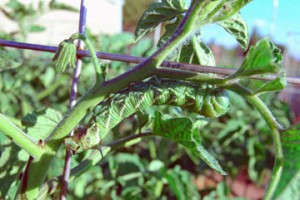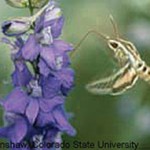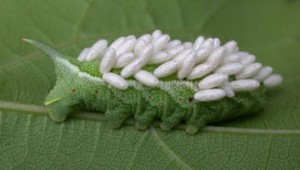By The Giant Veggie Gardener

Tomato hornworm
Be on the lookout for tomato hornworms right about now. They usually show up in July. This green caterpillar has white and black markings, is 3.5 to 4 inches long and is the larval stage of the Sphinx moth. This moth is also called the hawk moth or hummingbird moth. That’s right, that pretty little hummingbird moth is not so nice. It is actually not a hummingbird but an insect. It is called the hummingbird moth because of its long “beak” which is not really a beak at all, but a slender, tubular feeding organ. It is a grayish-colored moth with a wingspread of 4 to 5 inches. I see it visiting my flowers at dusk and at night. It is attracted particularly to purple flowering plants. The moth is not harmful to your plants, only its larva – the tomato hornworm.

Hummingbird moth or Sphinx moth
The first thing I do (after looking to see if the plants look good – no disease showing) is to see if any of the leaves are eaten. Luckily the hornworm usually starts feeding from the highest part of the plant first, not the interior of the plant. If I see the leaves eaten, then I also look for their poop (frass) – quite large pellets about 1/8 inch in size. You can see the frass sometimes on the branch or on the ground. Hornworms are hard to see as they blend in so well with the foliage, but keep looking around the damaged areas and you will find them.
Hornworms seem to hang upside down on the tomato branch – so look for them there. I usually have gardening gloves on because I am so squeamish about picking them off barehanded. They are so large they give me the creeps but they are quite beautiful. I prefer handpicking but if I found I had tons of them, I would spray with Bt (Bacillus thuringiensis). Bacillus thuringiensis is a live bacteria that kills only caterpillars. It doesn’t harm bees, birds or humans – only caterpillars. It is perfectly safe for organic growers. When the caterpillar takes a bite of a sprayed leaf, it dies. Bt interferes with their digestive system. You can buy it at a local nursery. The big box stores don’t carry it. The only bad thing about only Bt is that is washes off with the rain and must be reapplied.(This hasn’t been a big problem lately.)

Hornworm with wasp cocoons
Good old Mother Nature supplies the final helpful event. If you see little white cocoon things on a hornworm, leave them alone. The eggs are from a helpful parasitic wasp and the caterpillar will soon die. An added bonus is all the little wasps will then attack other hornworm caterpillars. The wasp is not like the wasp we think of that sting us. It is a little thing, almost fly-like, doesn’t sting and is one of those beneficial bugs you would like to have in your garden.


